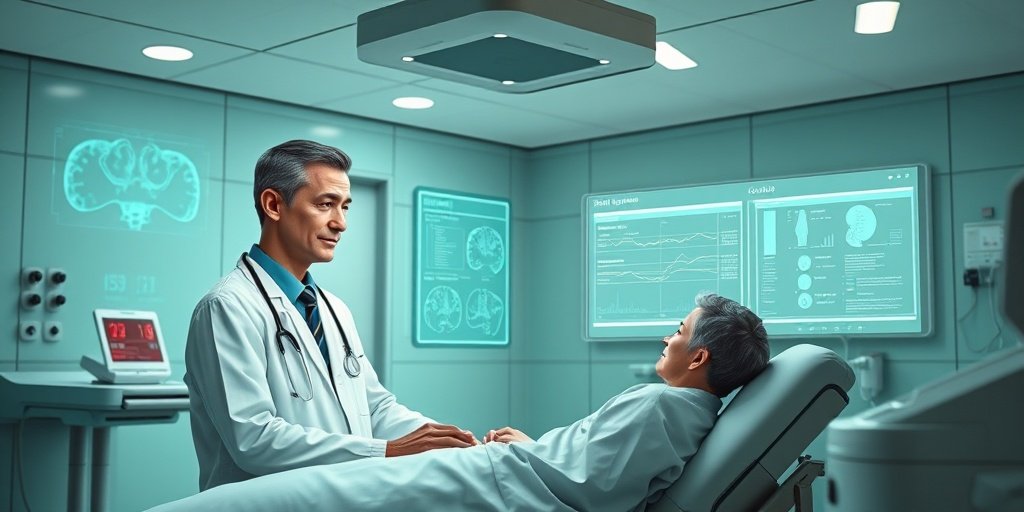⚡ Quick Summary
This study presents a groundbreaking full-process disease diagnosis and treatment assistance system utilizing generative artificial intelligence (GenAI). The system aims to enhance the efficiency and safety of medical practices through innovative tools and technologies.
🔍 Key Details
- 🏥 Institution: Haihe Hospital of Tianjin University in collaboration with the National Supercomputer Center and Tianjin University.
- ⚙️ Technology: Implementation of three models: Tianhe “Tianyuan”, WiNGPT, and DeepSeek.
- 🖼️ Features: Creation of digital avatars for chief physicians using multimodal intelligent interaction technology.
- 🛠️ Tools Developed: Intelligent inquiry, diagnosis recognition, treatment plan generation, and medical record assistance.
🔑 Key Takeaways
- 💡 Generative AI is transforming healthcare by integrating with existing hospital information systems.
- 📈 Enhanced Patient Interaction: Digital avatars provide a visual medical interaction solution for patients.
- 🔍 Intelligent Tools: The system includes tools for intelligent diagnosis and treatment planning.
- ⚡ Efficiency Improvement: Aims to improve the safety, quality, and efficiency of the diagnosis and treatment process.
- 🌐 Digital Transformation: Provides insights for the ongoing digital transformation in the healthcare industry.

📚 Background
The rapid advancement of artificial intelligence, particularly generative AI, is reshaping various sectors, including healthcare. This transformation presents both opportunities and challenges, particularly in diagnostic and therapeutic practices. The integration of AI technologies into healthcare systems is essential for improving patient outcomes and operational efficiency.
🗒️ Study
Conducted by Haihe Hospital of Tianjin University, this study focuses on the development of a comprehensive disease diagnosis and treatment assistance system based on generative AI. The project aims to enhance the hospital’s information center and integrate it with existing systems to support intelligent healthcare services.
📈 Results
The implementation of the system has led to the successful deployment of three AI models, which facilitate various intelligent services. These include tools for intelligent inquiry, diagnosis recognition, and treatment plan generation, significantly improving the overall efficiency and safety of medical practices.
🌍 Impact and Implications
The findings from this study highlight the potential of generative AI to revolutionize healthcare delivery. By enhancing the diagnostic and treatment processes, this system not only improves patient care but also sets a precedent for future digital transformations in the healthcare industry. The implications of such advancements could lead to more personalized and efficient healthcare services globally.
🔮 Conclusion
This study underscores the transformative power of generative AI in healthcare. By developing a full-process disease diagnosis and treatment assistance system, we are paving the way for a future where AI plays a crucial role in enhancing patient care and operational efficiency. Continued research and development in this area are essential for realizing the full potential of AI in healthcare.
💬 Your comments
What are your thoughts on the integration of AI technologies in healthcare? We would love to hear your insights! 💬 Please share your comments below or connect with us on social media:
[Development and application on a full process disease diagnosis and treatment assistance system based on generative artificial intelligence].
Abstract
The rapid development of artificial intelligence (AI), especially generative AI (GenAI), has already brought, and will continue to bring, revolutionary changes to our daily production and life, as well as create new opportunities and challenges for diagnostic and therapeutic practices in the medical field. Haihe Hospital of Tianjin University collaborates with the National Supercomputer Center in Tianjin, Tianjin University, and other institutions to carry out research in areas such as smart healthcare, smart services, and smart management. We have conducted research and development of a full-process disease diagnosis and treatment assistance system based on GenAI in the field of smart healthcare. The development of this project is of great significance. The first goal is to upgrade and transform the hospital’s information center, organically integrate it with existing information systems, and provide the necessary computing power storage support for intelligent services within the hospital. We have implemented the localized deployment of three models: Tianhe “Tianyuan”, WiNGPT, and DeepSeek. The second is to create a digital avatar of the chief physician/chief physician’s voice and image by integrating multimodal intelligent interaction technology. With generative intelligence as the core, this solution provides patients with a visual medical interaction solution. The third is to achieve deep adaptation between generative intelligence and the entire process of patient medical treatment. In this project, we have developed assistant tools such as intelligent inquiry, intelligent diagnosis and recognition, intelligent treatment plan generation, and intelligent assisted medical record generation to improve the safety, quality, and efficiency of the diagnosis and treatment process. This study introduces the content of a full-process disease diagnosis and treatment assistance system, aiming to provide references and insights for the digital transformation of the healthcare industry.
Author: [‘Yang W’, ‘Fu H’, ‘Meng X’, ‘Li C’, ‘Yu C’, ‘Zhao X’, ‘Li W’, ‘Zhao W’, ‘Wu Q’, ‘Chen Z’, ‘Cui C’, ‘Gao S’, ‘Wan Z’, ‘Han J’, ‘Zhao W’, ‘Han D’, ‘Jiang Z’, ‘Xing W’, ‘Yang M’, ‘Miao X’, ‘Sun H’, ‘Xing Z’, ‘Zhang J’, ‘Shi L’, ‘Zhang L’]
Journal: Zhonghua Wei Zhong Bing Ji Jiu Yi Xue
Citation: Yang W, et al. [Development and application on a full process disease diagnosis and treatment assistance system based on generative artificial intelligence]. [Development and application on a full process disease diagnosis and treatment assistance system based on generative artificial intelligence]. 2025; 37:477-483. doi: 10.3760/cma.j.cn121430-20250127-00093